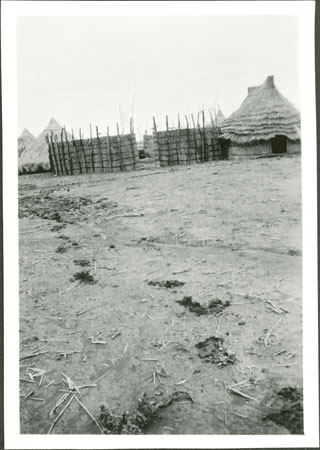Anuak headman's homestead

83 x 55 mm | Print gelatin silver
There are records relating to alternative images that we do not have scans for in the database:
1998.342.127.1 - Negative film nitrate , (83 x 55 mm)
1998.342.127.1 - Negative film nitrate , (83 x 55 mm)
Date of Print:
Unknown
Previous PRM Number:
EP.AK.127
Previous Other Number:
22 2 (226)
Accession Number:
1998.342.127.2
Description:
The homestead fence of a headmen of a village (unidentified), with elongated fence-posts (dikweri) carved with notches hoops.
This display was generally reserved for headmen only, but occasionally for other popular individuals of a village or nobles.
Photographer:
Edward Evan Evans-Pritchard
Date of Photo:
1935 March - May
Region:
[Southern Sudan] Jonglei
Group:
Anuak
PRM Source:
Edward Evan Evans-Pritchard
Acquired:
Donated 1966
Other Owners:
E. E. Evans-Pritchard Collection
Class:
Insignia , Settlement , Shelter , Carving
Keyword:
Fence , Building House
Primary Documentation:
PRM Accession Records - Accession Book Entry [p.
98] 1966.27 [1 - 24] G[ift] PROFESSOR E.
E.
EVANS-PRITCHARD; INST.
OF SOCIAL ANTHROPOLOGY, 51 BANBURY RD.
OXFORD - 1966.27.19 - S.
SUDAN, DARFUNG.
VARIOUS TRIBES.
Box of negatives in envelopes, [1 - 242] & 1966.27.20 - Box of prints of these negatives [refers to object 1966.27.19] [1 - 242], in envelopes.
Notes on print/mount - "22 2 226"
Notes on print/mount - "22 2 226"
Other Information:
In The Political System of the Anuak of the Anglo-Egyptian Sudan (monographs on Social Anthropology no.4, London School of Economics, 1940) E.
E.
Evans-Pritchard notes that 'A conspicuous sign of a headman's presence in a village are the notched poles (Plate IVb) that surround his court, a screened space in front of his homestead where he sits and talks to his people during the daytime.
These are called dikweri.
Usually the bark is stripped off the poles to the junction of the two branches or 'horns'.
The villagers erect these poles in front of, and around, his public enclosure, and sometimes round his private homestead as well.
They act as supports for a grass screen.
Such posts are found wherever there is a genuine headman' (page 40). This fence is the same as in 1998.342.122 [Chris Morton 8/1/2004]
Recorder:
Christopher Morton 8/1/2004 [Southern Sudan Project]

